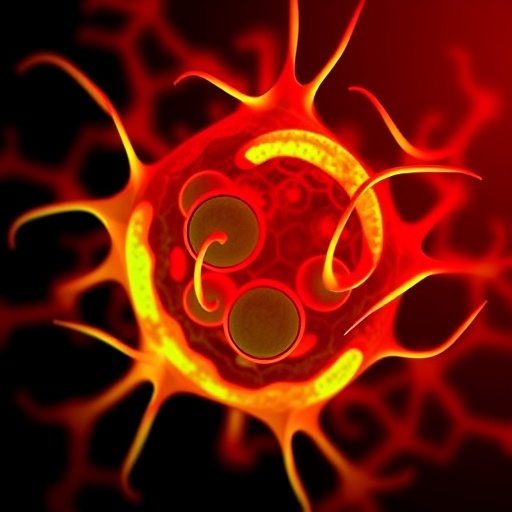
In the ever-evolving field of virology, understanding the intricate interactions between viruses and host cells remains a critical pursuit, particularly for pathogens as lethal and enigmatic as the rabies virus. The recent study led by Kroh, Rahmat, and Begeman, published in npj Viruses, sheds new light on the role of keratinocytes—specialized skin cells widely recognized for their structural and barrier functions—in the context of rabies virus infection. This groundbreaking research challenges long-standing paradigms that primarily focus on neurons as the exclusive cellular reservoirs for rabies virus replication and propagation. Instead, it posits that keratinocytes, which form the outermost layer of the skin, may significantly influence viral dynamics at the initial stages of infection and potentially affect disease progression.
Rabies virus, a member of the Lyssavirus genus, is notorious for its almost universally fatal neuroinvasive properties once clinical symptoms manifest. Traditional models underscore that the virus gains entry via peripheral nerve termini, often after a bite from an infected mammal, and then travels retrogradely through the nervous system en route to the central nervous system (CNS). However, the microenvironment immediately surrounding the site of inoculation—comprising various non-neuronal cells—is vastly underexplored. Keratinocytes, which outnumber all other skin cells, possess active immunological roles, secreting cytokines and chemokines that modulate local immune responses. The study addresses whether these cells serve merely as bystanders or active participants during rabies infection.
Employing a suite of sophisticated in vitro and ex vivo experimental platforms, the researchers demonstrated that keratinocytes can be productively infected by rabies virus under physiological conditions. Using advanced viral tracing and high-resolution microscopy, viral entry and translation machinery activation were visualized within infected keratinocytes. This denotes that these skin cells are not just passive barriers but can internalize and replicate rabies viral particles, suggesting an underestimated viral niche at peripheral tissues. Importantly, viral replication in keratinocytes occurred without the immediate induction of cytopathic effects, indicating a subtle subversion of host cell machinery, which may facilitate viral persistence or amplification prior to neural invasion.
.adsslot_slWauwJjTr{ width:728px !important; height:90px !important; }
@media (max-width:1199px) { .adsslot_slWauwJjTr{ width:468px !important; height:60px !important; } }
@media (max-width:767px) { .adsslot_slWauwJjTr{ width:320px !important; height:50px !important; } }
ADVERTISEMENT
Further biochemical assays revealed that the infection of keratinocytes triggers a distinctive array of innate immune signaling pathways. Notably, pattern recognition receptors such as Toll-like receptors (TLRs) and RIG-I-like receptors were modulated, leading to the production of type I interferons and pro-inflammatory cytokines. These signaling molecules are critical for orchestrating early antiviral defenses. However, the study’s transcriptomic analyses also uncovered viral mechanisms that dampen these immune responses, highlighting a nuanced virus-host interaction where rabies virus simultaneously stimulates and evades innate immunity within keratinocytes. This duality may contribute to the virus’s stealthy progression in peripheral tissues.
This research overturns the dogma that rabies virus dissemination relies solely on neural pathways by implicating keratinocytes as critical viral reservoirs that may modulate disease kinetics. By harboring infectious virus and affecting local immune landscapes, keratinocytes potentially serve as early amplifiers and gatekeepers of infection before neurological involvement. The researchers hypothesize that the virus-harboring keratinocyte population could facilitate sustained viral replication at the bite site, prolonging viral shedding and augmenting subsequent nerve uptake. This paradigm shift has profound implications for developing novel prophylactic measures or post-exposure therapies aimed at the earliest infection stages.
Importantly, the experimental data were obtained using human keratinocyte cultures and animal skin explants challenged with wild-type rabies virus strains, ensuring the physiological relevance of findings. Confocal imaging revealed colocalization of viral nucleoproteins within the keratinocyte cytoplasm, along with evidence of budding virions from the plasma membrane—hallmarks of active viral replication and egress. The study also characterized how rabies virus infection altered keratinocyte gene expression profiles, mapping the intricate molecular crosstalk that defines the infection signature in these cells.
Another remarkable aspect of the findings lies in the immunological crosstalk between infected keratinocytes and resident immune cells, such as Langerhans cells and dermal dendritic cells. The secretome of infected keratinocytes was shown to influence the activation and migration of these antigen-presenting cells, potentially shaping adaptive immune responses. This reveals an additional layer of complexity in how rabies virus infections orchestrate local and systemic immunity, possibly contributing to the elusive balance between immune evasion and activation characteristic of rabies pathogenesis.
The insights gleaned from this investigation open avenues for enhanced diagnostic and therapeutic strategies. Characterizing keratinocyte infection dynamics may lead to the identification of early viral biomarkers detectable in skin biopsies or scrapings from bite wounds, facilitating prompt rabies diagnosis. From a therapeutic standpoint, interventions that target viral replication within keratinocytes or enhance innate immune responses at the skin barrier could complement existing vaccine strategies, potentially reducing the time window required for effective post-exposure prophylaxis.
Furthermore, the distinction between keratinocyte susceptibility and response to different rabies virus strains was investigated. Some viral variants exhibited enhanced replication efficiency within keratinocytes, correlating with varying pathogenicity and transmission potentials observed in epidemiological data. This suggests that keratinocyte tropism could be a determinant of rabies virus strain virulence and warrants further investigation to unravel strain-specific pathogenic mechanisms.
The study also delved into the molecular determinants facilitating rabies virus entry into keratinocytes, identifying candidate surface receptors and endocytic pathways exploited by the virus. Utilizing receptor-blocking antibodies and endocytosis inhibitors, the researchers were able to reduce viral infection rates, underscoring potential molecular targets for antiviral drug development. The involvement of clathrin-mediated endocytosis and receptor-mediated uptake mechanisms was particularly emphasized, contributing a refined understanding of viral entry strategies outside neuronal contexts.
In addition to viral replication, the research explored how keratinocyte infection influences skin barrier integrity. While rabies virus infection did not induce overt cellular lysis, subtle alterations in tight junction proteins and cytoskeletal arrangements were observed, potentially compromising barrier functions. Disruption of skin homeostasis may facilitate viral dissemination or secondary infections, complicating disease outcomes. This highlights the importance of maintaining epidermal integrity as part of host defense against neurotropic viruses.
The temporal dynamics of keratinocyte infection were a focal point, with longitudinal studies demonstrating that rabies virus can persist for extended periods in these cells. This persistence could contribute to viral latency or reservoir formation in peripheral tissues, providing a sustained source of virus for neural invasion. Understanding the kinetics of keratinocyte infection and clearance mechanisms could inform therapeutic timing and improve clinical management of rabies exposure.
Moreover, the investigation addressed potential interactions between keratinocytes and peripheral nerves at the epidermal-dermal junction. Rabies virus was detected in both infected keratinocytes and adjacent nerve fibers, suggesting possible direct virus transfer or indirect facilitation of neural uptake through keratinocyte-mediated modulation. These findings add a spatial dimension to viral trafficking models and reinforce the multifaceted nature of rabies virus-host dynamics.
The multidisciplinary approach of this study, integrating virology, immunology, cell biology, and dermatology, exemplifies the complexity of viral infections beyond classical neurotropic paradigms. The recognition of keratinocytes as active participants in rabies virus life cycle and pathogenesis underscores a broader conceptual shift that may extend to other neuroinvasive viruses. This work inspires future investigations into peripheral tissue reservoirs and the early events dictating viral disease trajectories.
Ultimately, this pioneering research expands the scientific community’s understanding of rabies virus biology, with implications for public health interventions, vaccine enhancements, and antiviral drug discovery. By illuminating the contributory role of keratinocytes in rabies infection, Kroh and colleagues provide a foundation for reimagining how this deadly virus interacts with its human host right from the skin’s surface, the frontline of defense and infection.
Subject of Research: The role of infected keratinocytes during rabies virus infection.
Article Title: Exploring the role of infected keratinocytes during rabies virus infection.
Article References:
Kroh, K., Rahmat, R., Begeman, L. et al. Exploring the role of infected keratinocytes during rabies virus infection. npj Viruses 3, 53 (2025). https://doi.org/10.1038/s44298-025-00134-9
Image Credits: AI Generated
Tags: cellular reservoirs for rabies viruseffects of keratinocytes on disease progressionemerging research in virologyimmunological functions of keratinocytesneuroinvasive properties of rabies virusnon-neuronal cells in rabies pathologyrabies virus and skin immune responserabies virus infection mechanismsrabies virus transmission pathwaysrole of keratinocytes in viral dynamicsskin cells and viral interactionsvirology and host cell interactions


